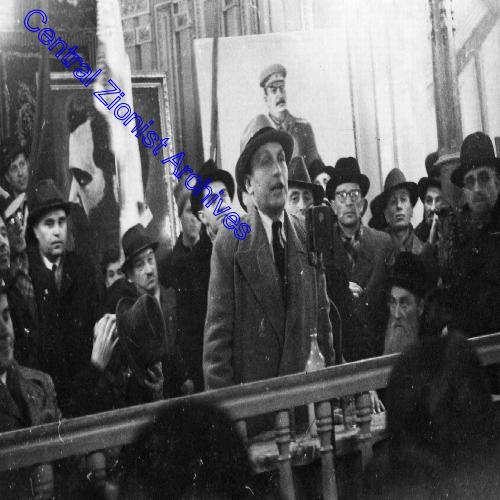
Romania was one of the first countries to recognize the State of Israel and established diplomatic relations with it in June 1948. Israel, for its part, raised the problem of emigration to the center of the relations between the two countries. Shortly after the declaration of the State of Israel, senior officials contacted Foreign Minister Ana Pauker, who promised to work to approve immigration from Romania.
Following a letter from March 11, 1949, signed by Israeli Foreign Minister Moshe Sharett, the Romanian authorities began organizing emigration and shipping on board a Romanian ship. The only one available for this purpose was Transylvania, which could transport up to 1,000 people.
On the eve of the large wave of immigration from 1950 to 1951, the Communist Party adopted a dual position: on one hand, emigration was permitted, while on the other hand, it carried out a propaganda campaign against emigration, which was considered a vote of 'no confidence' against the Communist regime, and a bad example for the Romanian citizens.
In 1950, following the decision to allow emigration, Jews stormed police stations in order to obtain applications for emigration. The Communist Party, surprised by the flood of requests, intensified its anti-Aliyah propaganda, and the “Securitate" - the secret police agency (Department of State Security), used means of terror and incitement against Zionist leaders and activists. In the summer of 1950, some 100 activists were arrested, brought to trial and severely punished.
In July 1950, restrictions were imposed on property that Jewish immigrantscould take with them; furniture, carpets, cars, works of art, and jewelry, except for one wedding ring, a clock, and personal religious objects, were forbidden. Immigrants were only allowed to take a few personal items, between 40 and 70 kilograms per person.
However, despite restrictions, intimidation, and the work of the Securitate, Israel and the Jewish organizations succeeded in convincing the authorities, from time to time, to allow the Jews to immigrate. Certificates were given in return for payment in various forms; trade preferences, industrial and agricultural technologies, and finally, in direct payment for each immigrant. In this way, approximately 120,000 Jews left Romania during 1948-1952, a third of the total Jewish population.
Since 1952, the Romanian government has begun to diminish the pace of emigration to Israel claiming that it has damaged the prestige of building socialism in Romania, another motive being the effect the Jewish emigration had on the Romanian economy.
Moreover, in 1952 the Romanian authorities took an extreme economic step, by replacing the promissory notes. This step severely harmed the Jews who were preparing for 'Aliyah'. Those who had sold their property in order to leave were left without valuables or money, and those who may have wanted to sell found it difficult to find buyers.
During that year, emigration was stopped, and those who had already submitted applications were "stuck" in Romania, pushed to the edges of the society by layoffs and placed in lower-level jobs that did not match their qualifications. Emigration resumed in 1959, after authorities set the price for each emigrant at a basic sum of fifty dollars, and for those with higher education an additional amount was required. By 1966, some 106,000 Jews had emigrated to Israel.
From 1965-1989, during Nicolae Ceausescu's rule, he founded a secretive financial trade in Jews, so as to not harm his country's image or his own. For that reason Romanians insisted on receiving payment for each emigrantin cash: an academic "cost" $3,000, a student $1,700 and a worker, $600. As the economic crisis worsened in Romania, the government raised the "price".
The sale of the Jews brought hundreds of millions of dollars into Romania, some of which disappeared into banks in Switzerland.